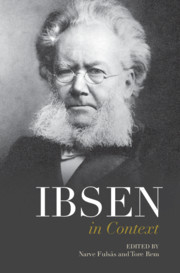Book contents
- Ibsen in Context
- Ibsen in Context
- Copyright page
- Contents
- Figures
- Contributors
- Preface
- Notes on the text
- Chronology
- Part I Life and Career
- Part II Culture and Society
- Chapter 4 Genres
- Chapter 5 Realism
- Chapter 6 Theatre
- Chapter 7 Visual Arts
- Chapter 8 Music
- Chapter 9 Philosophy
- Chapter 10 Science
- Chapter 11 Feminism
- Chapter 12 Capitalism
- Part III Scandinavian Reception
- Part IV Internationalization
- Part V Afterlives
- Further Reading
- Index
Chapter 12 - Capitalism
from Part II - Culture and Society
Published online by Cambridge University Press: 23 April 2021
- Ibsen in Context
- Ibsen in Context
- Copyright page
- Contents
- Figures
- Contributors
- Preface
- Notes on the text
- Chronology
- Part I Life and Career
- Part II Culture and Society
- Chapter 4 Genres
- Chapter 5 Realism
- Chapter 6 Theatre
- Chapter 7 Visual Arts
- Chapter 8 Music
- Chapter 9 Philosophy
- Chapter 10 Science
- Chapter 11 Feminism
- Chapter 12 Capitalism
- Part III Scandinavian Reception
- Part IV Internationalization
- Part V Afterlives
- Further Reading
- Index
Summary
This chapter traces how the material conditions and themes of Ibsen’s oeuvre reveal his interest in the culture of capitalism. The transformation of literary markets, the spread of economic ideas, and Ibsen’s financial struggles early in his career influenced both the content and form of his drama, which pays close attention to such prevalent features of nineteenth-century economic life as debt, credit, financialization and the invisible hand of the market. Although Ibsen never studied economics in depth, his own investment activities, coupled with his talent for observation, allowed him to capture European modernity in its transition from Christian ethos to the secular values of capitalism.
- Type
- Chapter
- Information
- Ibsen in Context , pp. 99 - 106Publisher: Cambridge University PressPrint publication year: 2021

